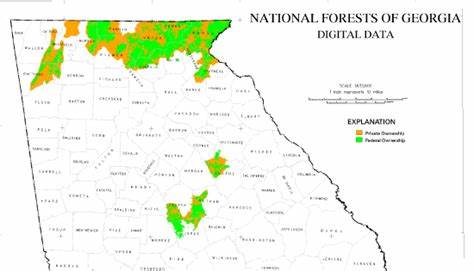UPDATE 4:30 P.M. WEDNESDAY:
The U.S. Forest Service, in cooperation with the Georgia Department of Natural Resources (GDNR), has temporarily closed all roads on Wildlife Management Areas (WMAs) within the Chattooga River Ranger District (CRRD) in anticipation of this weekend’s predicted snow event. The closures include roads on Chattahoochee WMA, Lake Russell WMA, and Warwoman WMA.
The temporary closures are being implemented to ensure public safety and protect road integrity during the severe weather. Roads will remain closed until they are assessed and deemed safe for travel after the weather event. CRRD staff, in collaboration with GDNR, will begin inspections early next week to determine when roads can be reopened. Factors such as elevation, aspect, and topography will influence thawing rates and road conditions.
Additionally, Sarah’s Creek Campground on Warwoman WMA will also be closed during this time.
The following roads are affected by the closures:
Chattahoochee WMA
Chattahoochee River Rd, FS# 44
White Oak Gap Rd, FS# 244
Lake Russell WMA
Guard Camp Rd, FS# 87
Red Root Rd, FS# 92
GA Mountain Orchard Rd, FS# 191
Brown’s Bottom Rd, FS# 92B
Curahee Mountain Rd, FS# 62
Warwoman WMA
Finney Creek Rd, FS# 152
Tuckaluge Creek Rd, FS# 153
Sarah’s Creek Rd, FS# 156
Sarah’s Creek Campground
Updates will be provided as road assessments progress.
ORIGINAL STORY. POSTED 3:30 P.M. WEDNESDAY:
With a mixture of snow, sleet and freezing rain across north Georgia later this week, the U.S. Forest Service (USFS) is issuing a Winter Weather Advisory to ensure the safety of visitors to the Chattahoochee-Oconee National Forest. The frozen mixture is expected to create hazardous trail and road conditions. “We strongly encourage visitors to avoid trails and recreation areas if winter weather becomes severe.” a news release says.
Additionally, high winds may increase the risk of falling trees and branches, especially in areas still recovering from Hurricane Helene’s damage in October. Visitors are advised to exercise extreme caution along ridge lines, including those on the Appalachian Trail, where exposure to high winds and damaged trees presents “an elevated risk.”
For anyone planning to hike during cold weather, the Forest Service offers these safety tips:
1. Check the weather Forecast: Always review the latest weather updates before heading out. Conditions can change rapidly in the forest.
2. Dress in Layers: Wear moisture-wicking base layers, insulating mid-layers, and waterproof outer layers. Avoid cotton, as it retains moisture.
3. Carry Proper Gear: Bring essentials such as:
- Insulated, waterproof boots
- Hats, gloves, and scarves
- Extra clothing in case of wet or freezing conditions
- Trekking poles for stability on icy terrain
4. Stay Hydrated and Energized: Bring plenty of water and high-energy snacks. Dehydration can still occur in cold weather.
5. Start Early: Daylight hours are shorter in winter. Aim to finish your hike well before sunset.
6. Know Your Limits: Avoid trails that are beyond your experience level, especially under snowy or icy conditions.
7. Carry Emergency Supplies: Pack a map, compass, whistle, flashlight, and fully charged phone. Consider a GPS device if you’re venturing into remote areas.
8. Tell Someone Your Plan: Share your itinerary with a trusted person and check in once you’re off the trail.
9. Avoid Risky Areas: Steer clear of icy slopes, frozen streams, and areas with a high concentration of damaged or leaning trees. Be especially cautious along ridge lines like those on the Appalachian Trail.
10. Stay Aware: Keep an eye on changing weather conditions and be prepared to turn back if conditions worsen.
For updates on trail conditions, closures, and weather-related advisories, visit https://www.fs.usda.gov/alerts/conf/alerts-notices or contact the ranger station nearest your planned visit.


